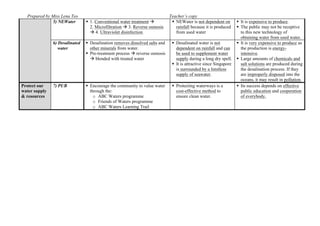S1 GE Handout 2 - Water Supply (Teacher)
- 1. Prepared by Miss Lena Teo Teacher’s copy did you know... Some washing machines use 6 liters of water per kg of clothes while others can use up to 20 liters per kg! And on average, a machine uses 50 liters of water. Thus, it is important to make sure that the new washing machine you buy is water efficient. Remember to adjust the water capacity according to the load you are washing as well!
- 2. Prepared by Miss Lena Teo Teacher’s copy Water Resource Management in Singapore Measure taken to avoid water shortage Explain the measure Describe the advantages Describe the disadvantages Reduce water demand by reducing water consumption 1) Pricing of water The water conservation tax is a pricing system where an additional amount of money is charged based on total water consumption. It thus encourages people to reduce their water consumption because the more water they use, the higher the tax rate. Water pricing allows people to be more mindful of their water consumption. It reflects the cost of producing clean water, thus people can appreciate the value of clean water. For industries that use a lot of water, water pricing increases their total cost of production. Water pricing may not affect those who can afford the higher price. Thus, they may continue to use any amount of water they want. 2) Public education PUB started the Water Efficiency Labelling Scheme to allow consumers to make informed choices when purchasing household products (encourages them to buy water-efficient products). In the PUB’s water-saving kit, there is a set of thimbles that can be placed on taps to allow residents to control the rate of water flow from their taps. Public education can teach many people about the importance of water in their lives. It has the potential to make lasting positive changes in people’s water use habits. It takes time to change people’s behavior. Its success depends on whether people want to change their behavior. Some people may ignore the advices given. Increase water supply 3) Local catchment water Rainwater collected in rivers, streams, drains, canals and stormwater collection ponds is channeled to reservoirs where it is stored. Local catchment takes advantage of Singapore’s high rainfall. Local catchment areas can also be recreational places. Land used for local catchment implies less land is available for other uses such as housing and industry. When there is little rainfall or a drought, local catchment areas are ineffective. 4) Import water Pipelines were built to transport water from Johor to Singapore. Importing water does not require land and hence frees up land for other uses. It is a cheaper source of water than desalinated water/NEWater Imported water may not be enough to meet water demands. Water agreements eventually expire and there is no guarantees of future agreements
- 3. Prepared by Miss Lena Teo Teacher’s copy 5) NEWater 1. Conventional water treatment 2. Microfiltration 3. Reverse osmosis 4. Ultraviolet disinfection. NEWater is not dependent on rainfall because it is produced from used water It is expensive to produce. The public may not be receptive to this new technology of obtaining water from used water. 6) Desalinated water Desalination removes dissolved salts and other minerals from water. Pre-treatment process reverse osmosis blended with treated water Desalinated water is not dependent on rainfall and can be used to supplement water supply during a long dry spell. It is attractive since Singapore is surrounded by a limitless supply of seawater. It is very expensive to produce as the production is energy- intensive. Large amounts of chemicals and salt solutions are produced during the desalination process. If they are improperly disposed into the oceans, it may result in pollution. Protect our water supply & resources 7) PUB Encourage the community to value water through the: o ABC Waters programme o Friends of Waters programme o ABC Waters Learning Trail Protecting waterways is a cost-effective method to ensure clean water. Its success depends on effective public education and cooperation of everybody.


